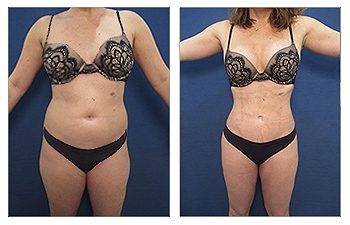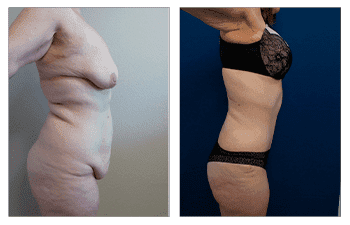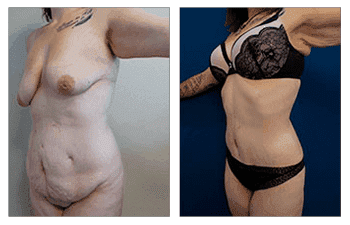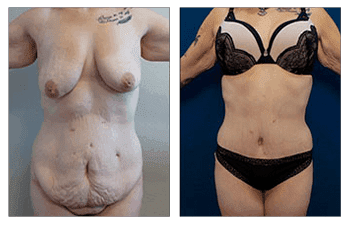




Download SurgiSculpt’s free Liposuction eBook
Introduction: Post Bariatric Tummy Tuck
The indications, operation, and outcomes for post bariatric tummy tuck contrast in scope with traditional tummy tuck surgery. An abdominoplasty, commonly referred to as a tummy tuck, is a cosmetic procedure that removes extra fat and skin to reduce the torso bulk, while also tightening the abdominal wall muscles. However, the traditional tummy tuck varies significantly from the conventional cosmetic patient who has not experienced massive weight loss after bariatric surgery.
The Post Bariatric tummy tuck
SurgiSculpt sets several goals to ensure the best post bariatric tummy tuck outcomes. These goals include creating:
- A maximally narrowed waistline to exaggerate an hourglass figure
- An innie belly button that can be shown off even when wearing a two-piece bikini
- A low incision line that is hidden in your undergarments
- Proper differential to muscle tightening that will provide aesthetic contour lines with an upper concave and lower convex abdomen
- Avoidance of lateral flank prominence termed dog ears
- Aggressive excision of redundant skin to avoid the recoil effect
Maximizing a narrowed waistline for the best post-bariatric tummy tuck
Maximizing a narrowed waistline is achieved by the maximum tightening of the abdominal muscles while preserving the attachment of overlying skin to the muscle. This ensures that the repaired muscles will pull in the skin and soft tissues centrally thereby maximizing waistline narrowing.
An “innie” belly button of post-bariatric tummy tuck
In a post-bariatric tummy tuck procedure, an innie belly button refers to an aesthetically pleasing belly button contour that creates a natural-appearing belly button contour along with the belly button incision that is positioned in the shadow of the belly button. To achieve an innie belly button, the umbilical stalk must be accurately identified utilizing an “Umbilicator” that was created and published by SurgiSculpt approximately 10 years ago.
A low incision line
A low incision line is critical so that your incision line can be hidden beneath your undergarments. In addition, a low incision line is critical to creating an aesthetically pleasing pubic region proportion.
Differential muscle plication
To recreate the finesse of the aesthetically pleasing female contour lines, the portion of the belly above the belly button must be slightly concave and the portion below the belly button must be slightly convex. This is accomplished by differentially tightening the muscles of the abdomen rather than providing uniform tightness throughout the belly.
Avoiding the dog ear
Dog ears refer to the fullness of the lateral flanks and back that can become even more evident once the tummy has been trimmed and tucked. This area must be addressed with either liposuction or extension of the tummy tuck incision onto the lateral flanks and lower back.
Aggressive excision of redundant skin to avoid recoil effect
n summary, a post-bariatric tummy tuck is a surgical procedure designed to address the excess skin and fat that remains in the abdominal area after significant weight loss. During the procedure, the surgeon removes the excess skin and fat, and tightens the deeper fascial tissues to create a smoother and firmer abdominal contour.
The excess skin removal is achieved through carefully placed incisions, which may vary depending on the patient’s specific needs and goals. Common incision patterns include a traditional tummy tuck incision, an extended tummy tuck incision, or a circumferential incision for a 360-degree body lift. These variations allow for customization of the procedure to address the specific concerns of severe skin redundancy that may extend to the flanks beyond the front side of the patient.
Next, aggressive excision of the abdominal skin flap must be performed being aware that severe weight loss patients will demonstrate recoil of the remaining abdominal skin resulting in recurrent skin redundancy even as early as a month following surgery. This phenomenon has been coined recurrent skin redundancy syndrome and describes the return of extra skin despite undergoing apparent elimination of skin redundancy.
Finally,, completing body contouring procedures in multiple stages may be recommended to ensure optimal results while reducing the risks of complications. This approach allows for the staged removal of excess skin and fat from different areas of the body, such as the abdomen, thighs, arms, and breasts, safely and effectively.
Overall, a post-bariatric tummy tuck can help patients achieve a more proportionate and toned physique after significant weight loss, addressing the excess skin and leaving them with a more contoured and sculpted abdominal area.
Why should I get a tummy tuck after weight loss?
After significant weight loss, many individuals are left with excess skin and stubborn fatty tissue that can be difficult to eliminate through diet and exercise alone. A tummy tuck, also known as abdominoplasty, can provide numerous benefits for individuals who have undergone weight loss and are struggling with sagging skin and lingering fatty tissue.
One of the main benefits of getting a tummy tuck after weight loss is the removal of excess skin, which can dramatically improve body contouring and provide a more aesthetically pleasing appearance. This can lead to increased confidence and a renewed sense of self-esteem. Additionally, a tummy tuck can address issues such as sagging skin and lingering fatty tissue, providing a more defined midsection and making it easier to maintain a healthy workout routine.
The post-weight loss tummy tuck is a great option for removing excess skin following significant weight loss, as it can help individuals achieve the body they have worked so hard for. By undergoing a tummy tuck, individuals can finally achieve the smooth, toned abdomen they have been striving for, further enhancing the results of their weight loss journey.
Recent Technologies in Post-Bariatric Body Contouring
Recent technologies in post-bariatric body contouring, such as non-invasive energy-based alternatives, have revolutionized the field by offering more advanced options to enhance cosmetic results and minimize complications. These technologies, including radiofrequency, ultrasound, and laser therapy, can effectively tighten and tone loose skin, reduce stubborn fat pockets, and improve overall body contour without the need for invasive surgery.
These non-invasive technologies may potentially replace invasive surgery for individuals with mild to moderate skin laxity, as they can provide significant improvements without the associated risks and downtime. For those with more significant laxity, these technologies can still be used to diminish the extent of surgery and resulting scars, as they can help to improve skin quality and elasticity before or after surgery. Additionally, non-invasive options can also be used in combination with surgical techniques to optimize results and minimize recovery time.
Overall, these advanced energy-based alternatives offer a promising alternative for individuals seeking post-bariatric body contouring, providing safe and effective solutions with impressive cosmetic outcomes and reduced risk of complications.
Enhance Your Bariatric Surgery Results with a Tummy Tuck
If you have undergone bariatric surgery and achieved significant weight loss, you may still have excess, loose folds of skin that can detract from your new body shape. A tummy tuck, also known as abdominoplasty, can enhance the results of bariatric surgery by removing this excess skin and providing a tighter, toned appearance. This body contouring procedure can help you achieve the desired body shape after significant weight loss and increase self-confidence.
The areas of the body most affected by loose, hanging skin after bariatric surgery include the abdomen, hips, thighs, and buttocks. A tummy tuck specifically targets the abdominal area, helping to address the sagging skin and improve the overall body contour. By removing the excess skin and tightening the underlying muscles, the procedure can help shape and define your midsection, giving you a more proportionate and balanced appearance.
If you have undergone bariatric surgery and are dealing with the aftermath of loose skin, consider the benefits of a tummy tuck to enhance your overall results and achieve a more sculpted physique. It can be a crucial step in completing your weight loss journey and feeling confident in your new body.
Contouring after Massive Weight Loss
Body contouring procedures are tailored to individuals who have undergone massive weight loss, whether through bariatric surgery or lifestyle changes. These procedures aim to address excess skin and tissue laxity in various areas of the body, including the abdomen, arms, thighs, and buttocks. Common body contouring procedures after massive weight loss include tummy tucks, arm lifts, thigh lifts, and lower body lifts.
Tummy tucks, also known as abdominoplasty, can be customized to meet the specific needs and cosmetic goals of the patient. Post-bariatric abdominoplasty techniques are specifically designed for individuals who have lost a significant amount of weight. These techniques focus on removing excess skin and tissue, tightening the abdominal muscles, and reshaping the midsection to achieve a more toned and smoother appearance.
Body contouring surgery can effectively remove excess skin and tighten surrounding tissue after bariatric surgery. This helps individuals achieve a more proportional and contoured body shape, which can improve self-confidence and quality of life after massive weight loss. Individuals need to consult with a board-certified plastic surgeon to discuss the available options for body contouring and determine the most suitable approach based on their unique needs and goals.
Post-Bariatric Body Contouring
Post-bariatric body contouring is a surgical procedure designed to address excess skin and tissue that remains after significant weight loss, typically following bariatric surgery or major lifestyle changes. This procedure helps individuals achieve a more proportionate and toned body shape by removing sagging skin, tightening underlying tissue, and enhancing the overall appearance. Post-bariatric body contouring can include various surgeries such as tummy tucks, thigh lifts, arm lifts, breast lifts, and more, tailored to each patient’s specific needs and goals. This transformative surgery can provide patients with a newfound confidence and improved quality of life by completing their weight loss journey and helping them feel comfortable in their skin.
How Body Contouring Plastic Surgery Works
Body contouring plastic surgery involves various procedures to enhance the shape and tone of the body. An arm lift, or brachioplasty, removes excess skin and fat from the upper arms, resulting in a more toned appearance. A breast lift, or mastopexy, reshapes and lifts sagging breasts by removing excess skin and tightening the surrounding tissue. A stomach lift, or abdominoplasty, removes excess skin and fat from the abdomen, while also tightening the abdominal muscles.
A lower body lift addresses the abdomen, buttocks, and thighs by removing excess skin and fat and lifting and tightening the remaining tissue. A thigh lift, or thighplasty, reshapes the thighs by removing excess skin and fat to achieve a more proportionate and toned appearance.
The sequence for conducting multiple surgeries depends on the patient’s individual needs and overall health. Typically, the procedures are spaced out to allow for proper healing and recovery. The specific techniques and considerations for each procedure may vary, but common steps include pre-operative evaluations, anesthesia, incisions, removal of excess skin and fat, tissue tightening, and the closing of incisions.
Overall, body contouring plastic surgery aims to enhance natural contours and achieve a more aesthetically pleasing appearance.
The Perfect Complement to Bariatric Surgery
The Fleur de Lis tummy tuck is the perfect complement to bariatric surgery, as it effectively removes excess abdominal skin and creates a more sculpted tummy. Body contouring surgery, such as the Fleur de Lis tummy tuck, can significantly improve functional problems associated with excess skin, such as skin irritation and back and joint pain. By eliminating the excess skin and creating a more streamlined abdominal area, patients can experience relief from these discomforts and enjoy an improved quality of life.
Moreover, the aesthetic benefits of the Fleur de Lis tummy tuck are equally significant. The procedure enhances the overall aesthetic appearance of problematic areas, resulting in a more toned and proportionate body contour. This can provide patients with a newfound confidence and satisfaction with their physical appearance, ultimately contributing to their overall well-being.
In conclusion, the Fleur de Lis tummy tuck is a highly beneficial procedure that not only addresses the physical discomforts and functional problems associated with excess abdominal skin but also enhances the aesthetic appearance of the body, making it an ideal complement to bariatric surgery.
How is Post Bariatric Tummy Tuck different than a Traditional Tummy Tuck?
The Post Bariatric Tummy Tuck differs from the Traditional Tummy Tuck in several ways, particularly in terms of surgical techniques and incisions used. In the Post Bariatric Tummy Tuck, the surgeon deals with excess skin and tissue resulting from significant weight loss, often employing more extensive surgical techniques to address the specific challenges of patients who have undergone massive weight loss. This may involve more complex incisions, as well as repositioning of the belly button to achieve optimal results.
The unique challenges of patients seeking a tummy tuck after significant weight loss include dealing with a large amount of excess skin and tissue that differs from the typical abdominal contour. These patients often have specific goals, such as achieving a more proportionate body shape and improving the appearance of the abdomen. The surgeon must take these factors into consideration while performing the Post Bariatric Tummy Tuck to ensure the best possible outcomes for the patient.
In contrast, the Traditional Tummy Tuck is typically performed on patients who have not experienced significant weight loss, and the surgical techniques and incisions used may be less extensive. Overall, the Post Bariatric Tummy Tuck involves more complex surgical procedures to address the challenges specific to patients who have undergone substantial weight loss.
Please appreciate the best tummy tuck candidate, a 30-years old female patient.
